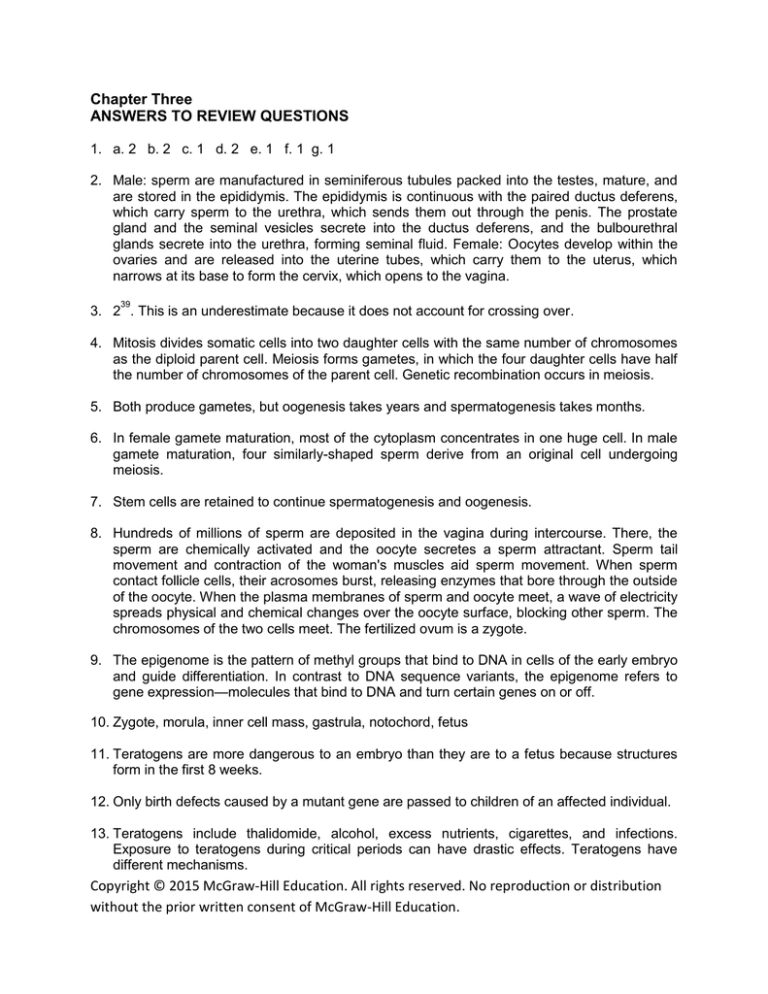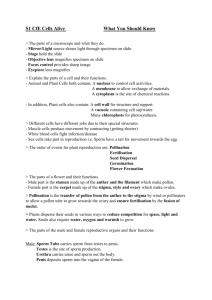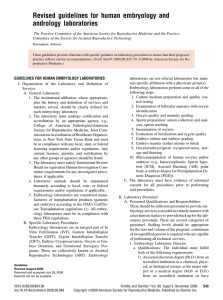
Chapter Three
ANSWERS TO REVIEW QUESTIONS
1. a. 2 b. 2 c. 1 d. 2 e. 1 f. 1 g. 1
2. Male: sperm are manufactured in seminiferous tubules packed into the testes, mature, and
are stored in the epididymis. The epididymis is continuous with the paired ductus deferens,
which carry sperm to the urethra, which sends them out through the penis. The prostate
gland and the seminal vesicles secrete into the ductus deferens, and the bulbourethral
glands secrete into the urethra, forming seminal fluid. Female: Oocytes develop within the
ovaries and are released into the uterine tubes, which carry them to the uterus, which
narrows at its base to form the cervix, which opens to the vagina.
39
3. 2 . This is an underestimate because it does not account for crossing over.
4. Mitosis divides somatic cells into two daughter cells with the same number of chromosomes
as the diploid parent cell. Meiosis forms gametes, in which the four daughter cells have half
the number of chromosomes of the parent cell. Genetic recombination occurs in meiosis.
5. Both produce gametes, but oogenesis takes years and spermatogenesis takes months.
6. In female gamete maturation, most of the cytoplasm concentrates in one huge cell. In male
gamete maturation, four similarly-shaped sperm derive from an original cell undergoing
meiosis.
7. Stem cells are retained to continue spermatogenesis and oogenesis.
8. Hundreds of millions of sperm are deposited in the vagina during intercourse. There, the
sperm are chemically activated and the oocyte secretes a sperm attractant. Sperm tail
movement and contraction of the woman's muscles aid sperm movement. When sperm
contact follicle cells, their acrosomes burst, releasing enzymes that bore through the outside
of the oocyte. When the plasma membranes of sperm and oocyte meet, a wave of electricity
spreads physical and chemical changes over the oocyte surface, blocking other sperm. The
chromosomes of the two cells meet. The fertilized ovum is a zygote.
9. The epigenome is the pattern of methyl groups that bind to DNA in cells of the early embryo
and guide differentiation. In contrast to DNA sequence variants, the epigenome refers to
gene expression—molecules that bind to DNA and turn certain genes on or off.
10. Zygote, morula, inner cell mass, gastrula, notochord, fetus
11. Teratogens are more dangerous to an embryo than they are to a fetus because structures
form in the first 8 weeks.
12. Only birth defects caused by a mutant gene are passed to children of an affected individual.
13. Teratogens include thalidomide, alcohol, excess nutrients, cigarettes, and infections.
Exposure to teratogens during critical periods can have drastic effects. Teratogens have
different mechanisms.
Copyright © 2015 McGraw-Hill Education. All rights reserved. No reproduction or distribution
without the prior written consent of McGraw-Hill Education.
14. Sirtuins are thought to affect energy metabolism in ways that delay or prevent common
disorders of aging, but the “sirtuin hypothesis” goes in and out of favor—more data are
needed.
15. Progerin contacts chromatin through the nuclear membrane, which hampers DNA repair.
Stem cell activities are skewed so that bones form and fat doesn’t, giving the child an aged
appearance.
16. Inherited accelerated aging disorders and studies on blood relatives of long-lived individuals
indicate that genes affect lifespan.
ANSWERS TO APPLIED QUESTIONS
1. Answers may vary. A commonly used cut-off point for experimentation is after the second
week, when primary germ layers begin to form.
2. The chromosomes in a polar body resulting from the first meiotic division would be
replicated, unlike those from the second meiotic division.
3. Yes
4. Prevents implantation
5. A polar body does not have enough cytoplasm and organelles to support an embryo.
6. Some people believe that a pregnant woman should be held legally responsible for
knowingly exposing an embryo or fetus to a teratogen. This article
(http://healthjournalism.org/blog/2014/09/blaming-moms-how-miscommunication-on-epigenetics-is-athreat-to-womens-health/) presents cases in which pregnant women were punished for taking
drugs.
7. Knowledge of inherited diseases or disease susceptibilities can inform and empower people
to live in ways that minimize those risks. On the other hand, not all ways of dying are
predictable, such as car accidents or acts of violence.
ANSWERS TO WEB ACTIVITIES
1. Control response to stress, sleep enough, do not smoke, do not drink alcohol, avoid
pollution, use sunscreen, use dental floss, exercise, and limit white carbohydrates. The large
number of controllable risk factors means that the environment plays a significant role in
longevity.
2. Three drugs with no evidence of danger during pregnancy: Benadryl, Acyclovir, Claritin.
Three drugs unsafe during pregnancy: Accutane (small head, heart defects, cleft lip and
palate, intellectual disability), aspirin (bleeding), Benzodiazepines (low birth weight, pre-term
birth, infant withdrawal).
Copyright © 2015 McGraw-Hill Education. All rights reserved. No reproduction or distribution
without the prior written consent of McGraw-Hill Education.
ANSWERS TO CASE STUDIES AND RESEARCH RESULTS
1. The cells of an 8-celled embryo are like each other, and the embryo’s genome is not very
active. The inner cell mass forms later, and cell differentiation begins. However, both of
these stages are before the three layers of the embryo form.
2. An important factor in a post-mortem gamete collection case is whether or not there is
evidence that the deceased person had wanted a child after death. A similar case
concerned egg removal from a dead young woman, while she was still in a coma. The
retrieval was not done, although her parents requested it, when the young woman’s
gynecologist showed records indicating that her patient had never mentioned having
children. This case is in chapter 21.
3. This is the result of a homeotic mutation, which disrupts how body parts “know” which
developmental program to follow.
4. Three clones of Orphan Black are not identical due to somatic mutations, environmental
influences, and different patterns of X inactivation.
5. Mutations are a natural consequence of the passage of time, and may not be harmful.
6. Siblings living significantly longer than spouses would indicate a genetic component to
longevity. If spouses are also very long-lived, the environment is more important.
Copyright © 2015 McGraw-Hill Education. All rights reserved. No reproduction or distribution
without the prior written consent of McGraw-Hill Education.









